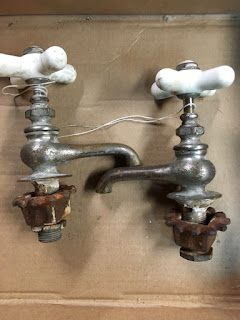A few weeks ago I was contacted, via my plumbing-geek web mail, by a new client in Texas who was restoring an 1850s cabin on a rural property there. He had been looking at lav taps on sites like Ebay to compliment the lavatory he was using. He told me that he was searching for a pair of taps that were "worn to brass". He had found a single tap that suited him but had not purchased it and wanted to know if I had a potential mate for it. He went on to say that if I had a pair in stock he would be interested in seeing them but that in any case, whether he provided or I did, he wanted me to work up a pair of taps for his cabin. In the original contact email he included the URL of the web page where the one tap was being offered. I looked it over and proceeded to root through my stock of unfinished taps for something that might match what I had seen on the web page, or failing that a pair that might be suitable. The two problems with the tap on the internet were that I couldn't tell it's size from the photo and I didn't know if it would turn out to be serviceable.
As I sorted the contents of boxes, selecting out singles and pairs tied together, looking at their surfaces with the term "worn to brass" in mind, the usual inner dialog was playing. I have never been a fan of the bare brass look. It reminds me of the early days of the restoration movement when people would strip old faucets of their nickle or chrome and install them in that raw state. From time to time someone would ask me to repair such a faucet or pair of taps and it always seemed so wrong to me, as a plumber with a mind set upon sanitation, to work on something that I just knew would get all green and funky. Those faucets were the very first vintage work I did though I didn't relish it at the time.
I laid out the result of my search and inspected what I could choose from. The term worn to brass was bugging me because it seemed so specific. I was looking at bare brass that had been tank stripped, wheel buffed, and maybe even sand blasted. A lot of my potential product had come in as a lot and I had been pulling the
best of it out for work, not the most worn looking. Now, looking at these pieces my intuition was giving me red lights. I went back to the office and contacted my client to confirm and make sure I was reading him right.
I asked, "When you say "worn to brass" I assume you are looking for authentic
aging and not stripped, sandblasted, or buffed down finishes".
I got back, "Thank you Brian and you are correct I basically want an unlacquered
brass finish of an older unit. If it was an original brass finish then
one with some patina. If it was nickel or chrome over brass then most of
the nickel and chrome pitted or worn in places to show the brass
beneath.
Thank you for your diligence".
The thing is, I was really becoming intrigued by this, and frustrated. Everything I looked at was off the mark. I understand patina but that usually concerns the remnant condition of a plated finish. For this project I was looking beyond patina to deep wear.











HI .... very interesting site ..... I have just bought some old taps of ebay Fr. and I am trying to take them apart but when i have unscrewed the "cover" in the middle I cant move the internal hex nut , should i screw the taps onto a wooden board / put oil on then give it a go ? ...... any sugggestions would be most helpful .......... Jonathan in France
ReplyDelete